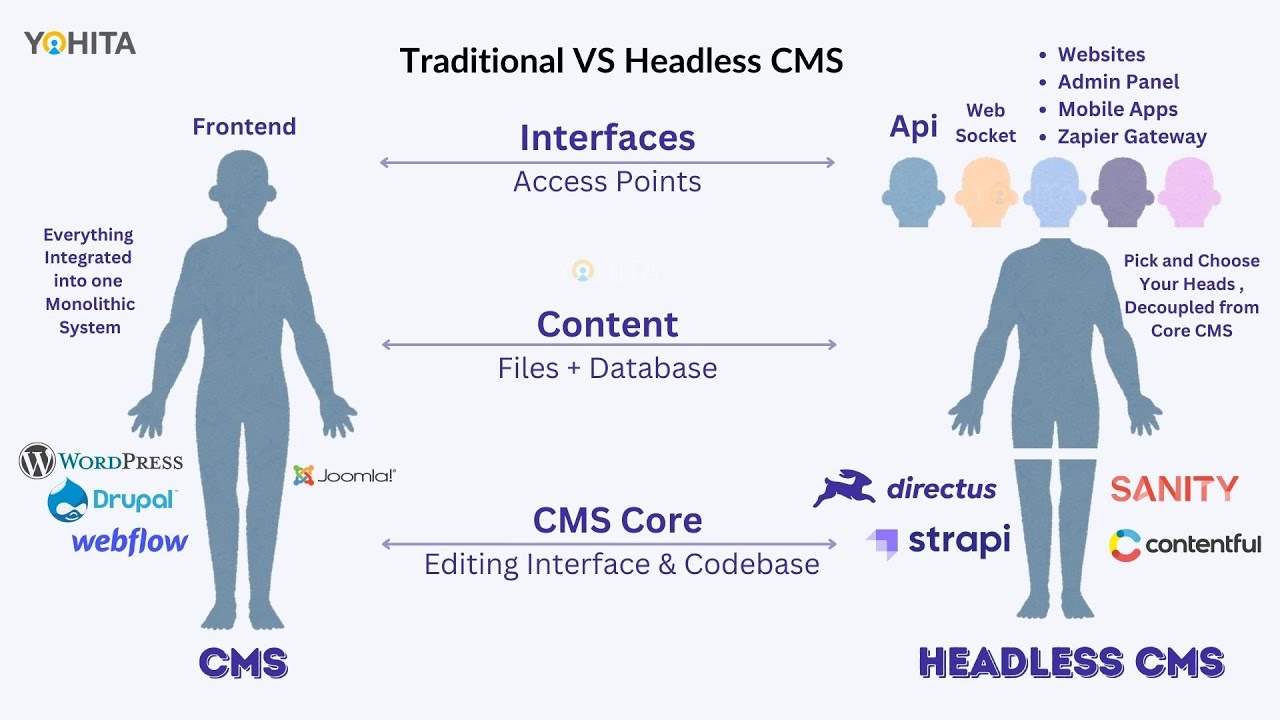A Content Management System (CMS) is essential for managing digital content. It typically consists of three main parts:
- Interface: The frontend that users see.
- Content: Stored in files and databases.
- CMS Core: The editor interface and codebase.
Let's dive into the differences between Traditional and Headless CMS.
What is a Traditional CMS?
A traditional CMS, also known as a coupled CMS, is an all-in-one solution that manages both the front-end and back-end of a website. Popular examples include WordPress, Joomla, and Drupal. These systems provide an integrated environment where you can create content, manage it, and publish it directly to your website.
Key Features of Traditional CMS:
- Integrated Front-end and Back-end: Everything is managed within a single platform.
- User-Friendly Interface: Typically offers a WYSIWYG (What You See Is What You Get) editor for easy content creation.
- Themes and Templates: Pre-designed themes and templates make it easy to set up and design a website without extensive coding knowledge.
- Plugins and Extensions: A vast array of plugins and extensions are available to add functionality.
What is a Headless CMS?
A headless CMS decouples the front-end from the back-end, providing a more flexible and scalable solution. It delivers content via APIs, allowing developers to build the front-end using any technology they choose. Examples of headless CMS include Contentful, Strapi, and Directus.
Key Features of Headless CMS:
- API-Driven: Content is delivered through RESTful APIs or GraphQL.
- Front-End Agnostic: Developers can use any front-end technology (e.g., React, Angular, Vue.js).
- Scalability: Designed to handle large-scale content delivery across multiple channels.
- Microservices Architecture: Often used in conjunction with microservices for a more modular approach.
Choosing the Right CMS:
When deciding between a traditional CMS and a headless CMS, consider the following factors:
- Project Requirements: Evaluate the specific needs of your project. If you need a quick, all-in-one solution for a simple website, a traditional CMS might be the best choice. For complex, scalable applications requiring omnichannel content delivery, a headless CMS is likely more suitable.
- Technical Expertise: Consider your team's technical capabilities. Traditional CMS platforms are generally easier for non-technical users, while headless CMS requires a more experienced development team.
- Budget and Timeline: Traditional CMS solutions can be quicker and cheaper to set up initially. However, if long-term scalability and flexibility are important, investing in a headless CMS could be more cost-effective over time.
- Future-Proofing: Think about your future needs. A headless CMS provides greater flexibility to adapt to new technologies and delivery channels, making it a better choice for future-proofing your digital presence.
Understand with Real time Example
Imagine you run an e-commerce business. Using a Traditional CMS like WordPress, you can manage your website effectively. However, if you want to expand your reach to a mobile app or smart TV interface, you might struggle with the limitations.
With a Headless CMS like Directus, you manage your product catalog in one place and serve it to your website, mobile app, and even a smart TV app seamlessly. This setup allows you to maintain a consistent user experience across all platforms while managing content from a single backend.
For a detailed walkthrough of Traditional vs Headless CMS, watch the video below:
Conclusion
Both Traditional and Headless CMS have their unique features. A Traditional CMS is excellent for simple, website-focused projects, while a Headless CMS offers the flexibility and scalability needed for multi-platform content delivery. Choose the one that best fits your project's needs and future growth plans.

